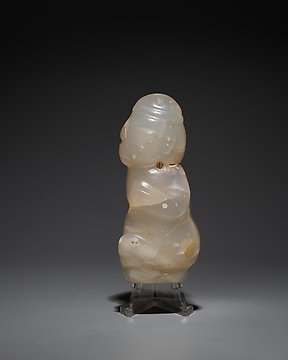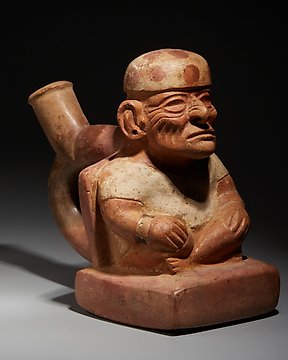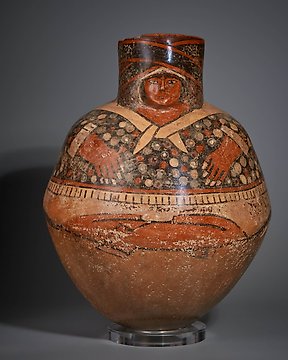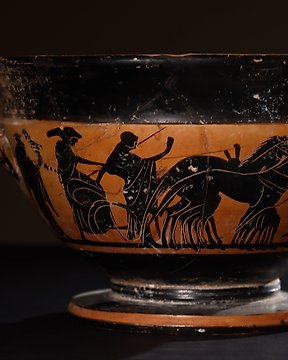Herzlichen Dank!
查看翻译大希腊,帕埃斯图姆 陶器 帕埃斯图姆阿斯特亚斯画家的钟形小瓶。公元前 4 世纪。高 31 厘米。TL 已测试。西班牙出口许可证。
编号 84871081
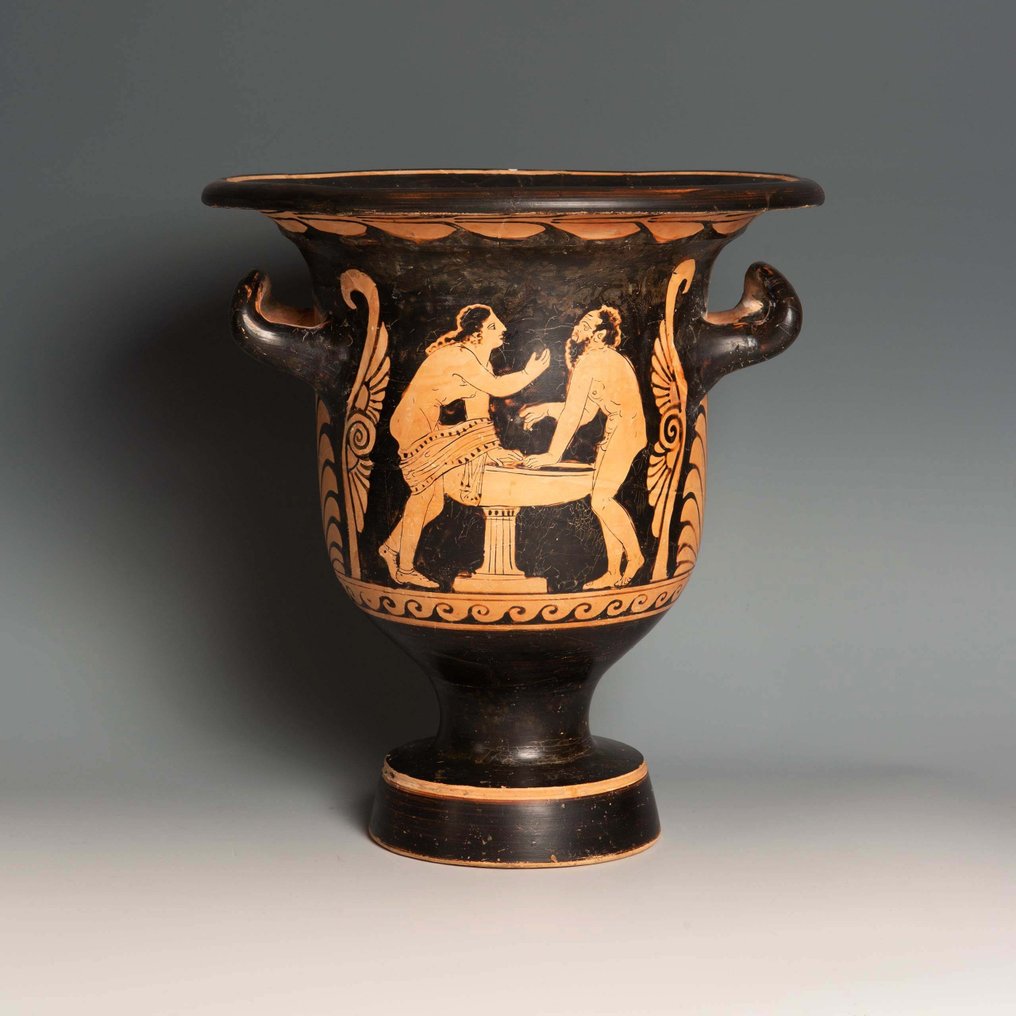
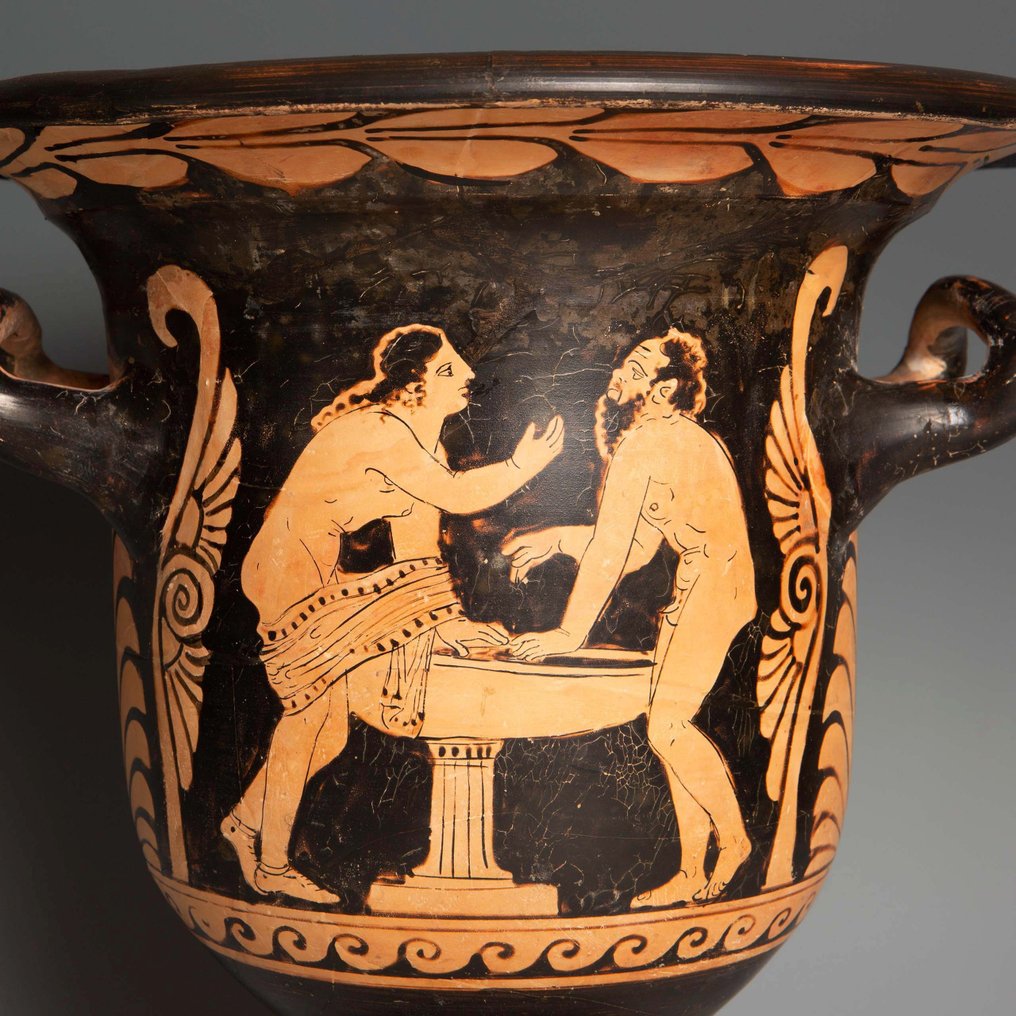
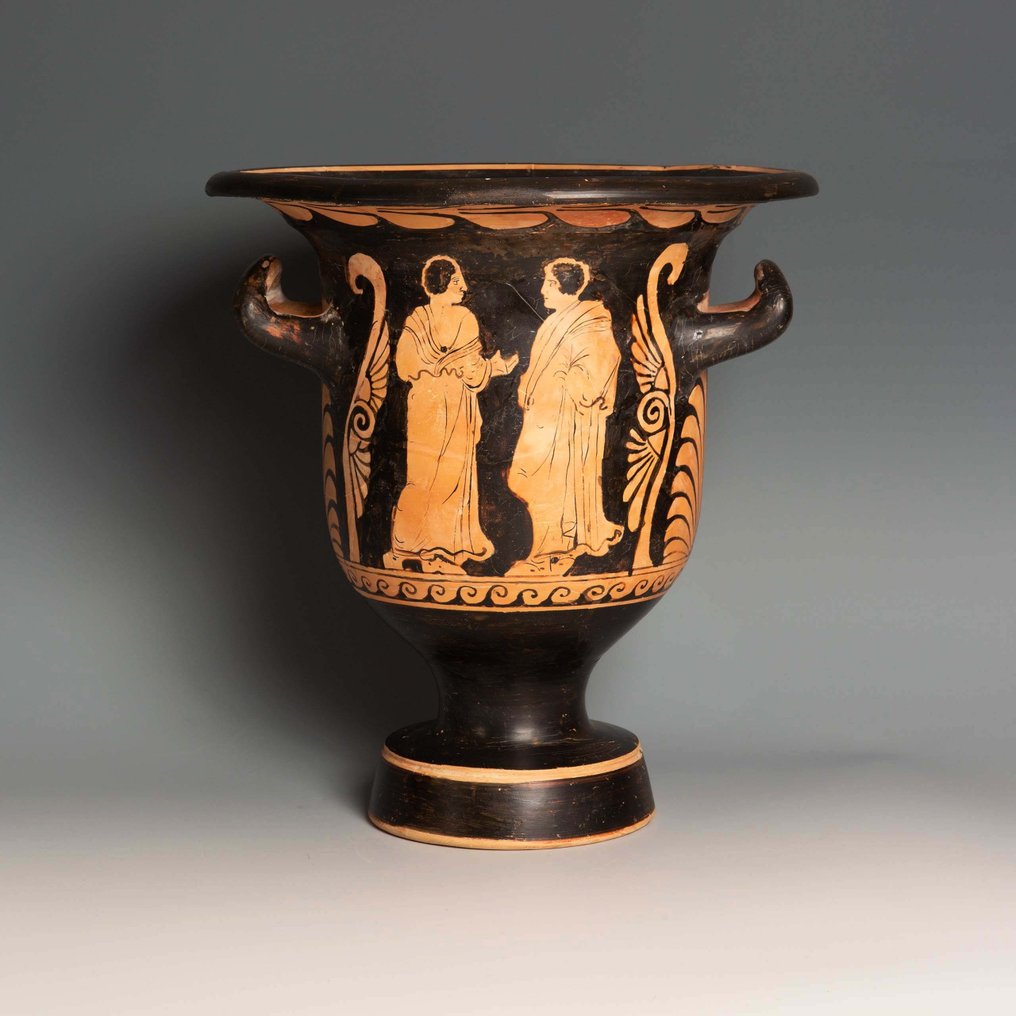
Bell krater of Asteas Painter
CULTURE: Magna Graecia, Paestum
EPOCA: Mid-fourth century B.C.
AUTHOR: Attributed to the painter Asteas
MATERIAL: Ceramic
DIMENSIONS: 31 cm in height and 31 cm in diameter
PROVENANCE:
- Private collection, Cannes, France.
- Purchased at the Pierre-Eric Becker Gallery, Cannes, 1998.
CONSERVATION: Good condition. Restored from original fragments. No repainting, only the lines have been covered.
DOCUMENTS: - Attached thermoluminescence test.
DESCRIPTION:
Crater with an inverted bell-shaped body, taller than wide, raised on a short foot with a truncated cone base. It has two arc-shaped handles, circular in section, which emerge horizontally from the upper half of the tank and bend inwards at the top. The mouth is wide, flat and with a rounded lip, and is joined to the tank through a truncated cone-shaped neck, differentiated from the body by a simple molding. The piece is decorated with the red figure technique, with a figurative scene on the front. Under the neck there is a laurel wreath forming a continuous frieze. Another frieze, which also surrounds the piece and in this case presents curved meanders to the right, forms the ground plane of the figurative scenes. On either side of these is a typically Paestan ornamental motif, believed to have been invented by Asteas himself: pairs of half palmettes flanking the scenes, composing a symmetrical scheme in relation to the full palmettes under the handles. In New York a krater attributed to Asteas (fig. 1) is preserved, very close to the piece under study both for the typology of the ceramic (stylized, with horizontal handles, truncated cone foot and mouth with a large projection) and for the decoration: identical ornamental motifs and two scenes with two characters each, the main one with a Dionysian theme and the secondary one with young people conversing.
On the main face of the crater there is a scene with two characters, possibly a maenad and a satyr. Both appear naked, although the woman wears a delicate shoe tight to the foot and is partly covered with a mantle of embroidered profiles, similar to others represented by the same painter (fig. 2), which will become a common detail in the ceramics of Paestana due to its influence. The figures are represented in profile, with the weight of the body resting on a single foot, the other being slightly raised, and the torso forward to approach each other. The faces, in strict profile, look at each other. Between them is a basin in the form of a large cup with a fluted column foot, with water inside. The maenad and the satyr rest one of their hands on the basin, approaching each other without touching. The woman also advances her raised right hand towards her companion, a gesture that the latter seems to be about to reply. The satyr is represented with a completely human appearance except for the pointed ears, a detail that appears in other works by the same author (fig. 3). On the other hand, this way of placing the two characters, leaning forward and leaning on a central basin, can also be found in two gamikoi lebetes decorated by Asteas or his workshop (figs. 4 and 5).
The back of the crater depicts a common theme, that of young people dressed in himation in a conversation scene. This is a motif that comes from Attic pottery, but that will enjoy an enormous development within Magna Graecia, especially as a secondary scene in the craters. In this case it is two characters, looking at each other. The one on the left shows the torso from the front and the body in profile, advances towards his companion and advances his right hand in a gesture that indicates that he is speaking. The other hand is hidden under his clothes. The second young man appears in a relaxed position, with his body completely in profile, one leg bent and both hands covered by the himation, the left hand resting on his hip. This is a very similar composition to that on another bell krater attributed to Asteas, preserved in London (fig. 6), although in this case the figure on the right is female.
Asteas (act. ca. 360-340 BC) was the most prominent red figure painter of Paestum, founder of the first workshop of this center and author of a considerable corpus of pieces. His workshop, directed in collaboration with Python, the other great artist of the Paestum school, was especially important for the quantity and quality of its production. Asteas and Python were painters of great artistic and technical level, and together they established the stylistic canon of Paestan red-figure ceramics, which remained unchanged until their disappearance.
Eleven vases signed by Asteas are preserved, all of them large pieces with particularly ambitious compositions. His simpler works, mainly bell kraters and gamikoi lebetes, often show a more lively and attractive style. Asteas is considered the originator of the free-standing half-palmettes that commonly flank figurative scenes on Paestum pottery. His vessels show mainly Dionysian scenes, very popular in Magna Graecia, although he also represented mythological themes and scenes from the farce flíaca, a theatrical genre developed in southern Italy. In the rear area he represented, preferably, scenes with two or three young people conversing.
Paestum was the center of one of the five schools of red-figure pottery in southern Italy. It was started by craftsmen from Sicily around 360 BC, making it the last of the Magna Graecia styles to develop. The first workshop founded in the city was that of Asteas and Pythias, the only vase painters in southern Italy known for the inscriptions preserved on their pieces. Their style enjoyed a great influence on the Paestum school, and in fact the second workshop in the city, founded around 330, closely followed their models. However, the production of Paestum ceramics soon showed a clear decline in quality and variety of motifs and, by the year 300, production completely disappeared.
Paestana pottery is characterized by certain specific ornamental elements that are repeated: lateral palmettes, friezes of tendrils with calyxes and crowns ("flower of Asteas"), crests on the garments and figures with loose curly hair, often leaning forward while leaning on plants or rocks. Likewise, the use of additional colors such as white, ochre, black, purple and gradations of red will be frequent in these vessels. As for the subject matter represented, in these Paestum vases Dionysian scenes will predominate, especially thiasos and symposia, and the appearance of Aphrodite and Eros, Apollo, Athena and Hermes will also be frequent.
The crater is a type of Greek pottery used to contain a mixture of water and wine, with which the cups were filled. It was moved to the place of the meal and placed on the floor or on a platform, and the cupbearer administered the liquid with a spoon, filling the cups of the diners. The craters were mainly made of ceramic but also in precious metals, and were modeled in different shapes according to the taste of the artist, although always maintaining a very wide mouth. The most common shapes are the column, chalice, bell and scroll kraters. The bell-shaped krater, typology represented by the piece under study, is differentiated by the inverted bell shape and by the short arched handles, oriented upwards and located in the upper half of the tank.
Red-figured pottery was one of the most important figurative styles of Greek pottery. It was developed in Athens around 520 B.C., and was used until the third century B.C. It replaced the previous predominant style of black-figure pottery after a few decades. The technical basis was the same in both cases, but in the red figures the coloring is inverted, the figures being highlighted on a dark background, as if they were illuminated by a theatrical light, following a more natural scheme. Painters working with black figures were forced to keep the motifs well separated from each other and to limit the complexity of the illustration. In contrast, the red-figure technique allowed greater freedom. Each figure was silhouetted against a black background, allowing painters to portray anatomical details with more accuracy and variety.
The technique consisted of painting the motifs on the still wet piece, using a transparent varnish that, when fired, acquired an intense black hue. Therefore, the motifs were invisible before firing, which meant that the painters had to work entirely from memory, without being able to see their previous work. Once the piece was fired, the areas not covered by the glaze remained with the reddish tone of the clay, while the glazed, "painted" areas took on a dense, shiny black color.
PARALLELS:
Fig. 1 Bell crater with satyr and Dionysos, attributed to Asteas. Paestum, Magna Graecia, ca. 360-340 B.C., pottery. British Museum, London, inv. 1772,0320.149.
Fig. 2 Bell crater with Eros and Dionysos, attributed to Asteas. Paestum, Magna Graecia, ca. 360-340 B.C., pottery. British Museum, London, inv. 1824,0501.40.
Fig. 3 Bell crater with satyr and Dionysos, attributed to Asteas. Paestum, Magna Graecia, ca. 360-350 B.C., pottery. Metropolitan Museum, New York, inv. 62.11.3.
Fig. 4 Gamic Lebes with female initiation scene, Asteas and Pythias workshop. Paestum, Magna Grecia, ca. 340-320 B.C., ceramics. National Archaeological Museum, Madrid, inv. 1999/99/146.
Fig. 5 Gamic lebes with female initiation scene, Asteas Group. Paestum, Magna Grecia, ca. 360-320 B.C., pottery. National Archaeological Museum, Madrid, inv. 11445.
Fig. 6 Bell crater with Dionysos and comedy actor, attributed to Asteas. Paestum, Magna Graecia, ca. 360-340 BC, pottery. British Museum, London, inv. 1772,0320.661.
BIBLIOGRAPHY:
- Corpus Vasorum Antiquorum. Paris: Union Académique Internationale, www.cvaonline.org
- BOARDMAN, J. The History of Greek Vases: Potters, Painters, Pictures. Thames & Hudson. 2001.
- DENOYELLE, M.; IOZZO, M. La céramique grecque d’Italie Méridionale et de Sicile. A. J. Picard. 2009.
- HURSCHMANN, R. “Paestanische Vasenmalerei”, en Der Neue Pauly, vol. 9. Metzler Verlag. 2000.
- MAYO, M. (ed.). The Art of South Italy, Vases from Magna Graecia. Richmond. 1982.
- TRENDALL, A. D. The Red-Figured Vases of Paestum. British School at Rome. 1987.
- TRENDALL, A.D. Red Figure Vases of South Italy and Sicily. Thames and Hudson. 1989.
Notes:
The seller guarantees that he acquired this piece according to all national and international laws related to the ownership of cultural property. Provenance statement seen by Catawiki.
The piece includes authenticity certificate.
The piece includes Spanish Export License.
THE MINISTRY OF CULTURE FROM SPAIN ASKS ALL SELLERS FOR INVOICES OR OTHER DOCUMENTATION ABLE TO PROVE THE LEGALITY OF EACH ITEM BEFORE PROVIDING AN IMPORT OR EXPORT LICENSE.
#MorganNiquetCollection
卖家故事
Bell krater of Asteas Painter
CULTURE: Magna Graecia, Paestum
EPOCA: Mid-fourth century B.C.
AUTHOR: Attributed to the painter Asteas
MATERIAL: Ceramic
DIMENSIONS: 31 cm in height and 31 cm in diameter
PROVENANCE:
- Private collection, Cannes, France.
- Purchased at the Pierre-Eric Becker Gallery, Cannes, 1998.
CONSERVATION: Good condition. Restored from original fragments. No repainting, only the lines have been covered.
DOCUMENTS: - Attached thermoluminescence test.
DESCRIPTION:
Crater with an inverted bell-shaped body, taller than wide, raised on a short foot with a truncated cone base. It has two arc-shaped handles, circular in section, which emerge horizontally from the upper half of the tank and bend inwards at the top. The mouth is wide, flat and with a rounded lip, and is joined to the tank through a truncated cone-shaped neck, differentiated from the body by a simple molding. The piece is decorated with the red figure technique, with a figurative scene on the front. Under the neck there is a laurel wreath forming a continuous frieze. Another frieze, which also surrounds the piece and in this case presents curved meanders to the right, forms the ground plane of the figurative scenes. On either side of these is a typically Paestan ornamental motif, believed to have been invented by Asteas himself: pairs of half palmettes flanking the scenes, composing a symmetrical scheme in relation to the full palmettes under the handles. In New York a krater attributed to Asteas (fig. 1) is preserved, very close to the piece under study both for the typology of the ceramic (stylized, with horizontal handles, truncated cone foot and mouth with a large projection) and for the decoration: identical ornamental motifs and two scenes with two characters each, the main one with a Dionysian theme and the secondary one with young people conversing.
On the main face of the crater there is a scene with two characters, possibly a maenad and a satyr. Both appear naked, although the woman wears a delicate shoe tight to the foot and is partly covered with a mantle of embroidered profiles, similar to others represented by the same painter (fig. 2), which will become a common detail in the ceramics of Paestana due to its influence. The figures are represented in profile, with the weight of the body resting on a single foot, the other being slightly raised, and the torso forward to approach each other. The faces, in strict profile, look at each other. Between them is a basin in the form of a large cup with a fluted column foot, with water inside. The maenad and the satyr rest one of their hands on the basin, approaching each other without touching. The woman also advances her raised right hand towards her companion, a gesture that the latter seems to be about to reply. The satyr is represented with a completely human appearance except for the pointed ears, a detail that appears in other works by the same author (fig. 3). On the other hand, this way of placing the two characters, leaning forward and leaning on a central basin, can also be found in two gamikoi lebetes decorated by Asteas or his workshop (figs. 4 and 5).
The back of the crater depicts a common theme, that of young people dressed in himation in a conversation scene. This is a motif that comes from Attic pottery, but that will enjoy an enormous development within Magna Graecia, especially as a secondary scene in the craters. In this case it is two characters, looking at each other. The one on the left shows the torso from the front and the body in profile, advances towards his companion and advances his right hand in a gesture that indicates that he is speaking. The other hand is hidden under his clothes. The second young man appears in a relaxed position, with his body completely in profile, one leg bent and both hands covered by the himation, the left hand resting on his hip. This is a very similar composition to that on another bell krater attributed to Asteas, preserved in London (fig. 6), although in this case the figure on the right is female.
Asteas (act. ca. 360-340 BC) was the most prominent red figure painter of Paestum, founder of the first workshop of this center and author of a considerable corpus of pieces. His workshop, directed in collaboration with Python, the other great artist of the Paestum school, was especially important for the quantity and quality of its production. Asteas and Python were painters of great artistic and technical level, and together they established the stylistic canon of Paestan red-figure ceramics, which remained unchanged until their disappearance.
Eleven vases signed by Asteas are preserved, all of them large pieces with particularly ambitious compositions. His simpler works, mainly bell kraters and gamikoi lebetes, often show a more lively and attractive style. Asteas is considered the originator of the free-standing half-palmettes that commonly flank figurative scenes on Paestum pottery. His vessels show mainly Dionysian scenes, very popular in Magna Graecia, although he also represented mythological themes and scenes from the farce flíaca, a theatrical genre developed in southern Italy. In the rear area he represented, preferably, scenes with two or three young people conversing.
Paestum was the center of one of the five schools of red-figure pottery in southern Italy. It was started by craftsmen from Sicily around 360 BC, making it the last of the Magna Graecia styles to develop. The first workshop founded in the city was that of Asteas and Pythias, the only vase painters in southern Italy known for the inscriptions preserved on their pieces. Their style enjoyed a great influence on the Paestum school, and in fact the second workshop in the city, founded around 330, closely followed their models. However, the production of Paestum ceramics soon showed a clear decline in quality and variety of motifs and, by the year 300, production completely disappeared.
Paestana pottery is characterized by certain specific ornamental elements that are repeated: lateral palmettes, friezes of tendrils with calyxes and crowns ("flower of Asteas"), crests on the garments and figures with loose curly hair, often leaning forward while leaning on plants or rocks. Likewise, the use of additional colors such as white, ochre, black, purple and gradations of red will be frequent in these vessels. As for the subject matter represented, in these Paestum vases Dionysian scenes will predominate, especially thiasos and symposia, and the appearance of Aphrodite and Eros, Apollo, Athena and Hermes will also be frequent.
The crater is a type of Greek pottery used to contain a mixture of water and wine, with which the cups were filled. It was moved to the place of the meal and placed on the floor or on a platform, and the cupbearer administered the liquid with a spoon, filling the cups of the diners. The craters were mainly made of ceramic but also in precious metals, and were modeled in different shapes according to the taste of the artist, although always maintaining a very wide mouth. The most common shapes are the column, chalice, bell and scroll kraters. The bell-shaped krater, typology represented by the piece under study, is differentiated by the inverted bell shape and by the short arched handles, oriented upwards and located in the upper half of the tank.
Red-figured pottery was one of the most important figurative styles of Greek pottery. It was developed in Athens around 520 B.C., and was used until the third century B.C. It replaced the previous predominant style of black-figure pottery after a few decades. The technical basis was the same in both cases, but in the red figures the coloring is inverted, the figures being highlighted on a dark background, as if they were illuminated by a theatrical light, following a more natural scheme. Painters working with black figures were forced to keep the motifs well separated from each other and to limit the complexity of the illustration. In contrast, the red-figure technique allowed greater freedom. Each figure was silhouetted against a black background, allowing painters to portray anatomical details with more accuracy and variety.
The technique consisted of painting the motifs on the still wet piece, using a transparent varnish that, when fired, acquired an intense black hue. Therefore, the motifs were invisible before firing, which meant that the painters had to work entirely from memory, without being able to see their previous work. Once the piece was fired, the areas not covered by the glaze remained with the reddish tone of the clay, while the glazed, "painted" areas took on a dense, shiny black color.
PARALLELS:
Fig. 1 Bell crater with satyr and Dionysos, attributed to Asteas. Paestum, Magna Graecia, ca. 360-340 B.C., pottery. British Museum, London, inv. 1772,0320.149.
Fig. 2 Bell crater with Eros and Dionysos, attributed to Asteas. Paestum, Magna Graecia, ca. 360-340 B.C., pottery. British Museum, London, inv. 1824,0501.40.
Fig. 3 Bell crater with satyr and Dionysos, attributed to Asteas. Paestum, Magna Graecia, ca. 360-350 B.C., pottery. Metropolitan Museum, New York, inv. 62.11.3.
Fig. 4 Gamic Lebes with female initiation scene, Asteas and Pythias workshop. Paestum, Magna Grecia, ca. 340-320 B.C., ceramics. National Archaeological Museum, Madrid, inv. 1999/99/146.
Fig. 5 Gamic lebes with female initiation scene, Asteas Group. Paestum, Magna Grecia, ca. 360-320 B.C., pottery. National Archaeological Museum, Madrid, inv. 11445.
Fig. 6 Bell crater with Dionysos and comedy actor, attributed to Asteas. Paestum, Magna Graecia, ca. 360-340 BC, pottery. British Museum, London, inv. 1772,0320.661.
BIBLIOGRAPHY:
- Corpus Vasorum Antiquorum. Paris: Union Académique Internationale, www.cvaonline.org
- BOARDMAN, J. The History of Greek Vases: Potters, Painters, Pictures. Thames & Hudson. 2001.
- DENOYELLE, M.; IOZZO, M. La céramique grecque d’Italie Méridionale et de Sicile. A. J. Picard. 2009.
- HURSCHMANN, R. “Paestanische Vasenmalerei”, en Der Neue Pauly, vol. 9. Metzler Verlag. 2000.
- MAYO, M. (ed.). The Art of South Italy, Vases from Magna Graecia. Richmond. 1982.
- TRENDALL, A. D. The Red-Figured Vases of Paestum. British School at Rome. 1987.
- TRENDALL, A.D. Red Figure Vases of South Italy and Sicily. Thames and Hudson. 1989.
Notes:
The seller guarantees that he acquired this piece according to all national and international laws related to the ownership of cultural property. Provenance statement seen by Catawiki.
The piece includes authenticity certificate.
The piece includes Spanish Export License.
THE MINISTRY OF CULTURE FROM SPAIN ASKS ALL SELLERS FOR INVOICES OR OTHER DOCUMENTATION ABLE TO PROVE THE LEGALITY OF EACH ITEM BEFORE PROVIDING AN IMPORT OR EXPORT LICENSE.
#MorganNiquetCollection
卖家故事
- 747
- 6
- 0
All OK and with very fast shipping.
查看翻译Prachtig schilderij. Zo blij mee. Zeer nette verkoper en zeer snelle levering.
查看翻译perfect ! very fast and high quality delivery !
查看翻译All well! Thanks.
查看翻译Vendeur très professionnel, top +++×
查看翻译Photos trop contrastées pour bien percevoir les défauts, mais ces défauts étaient visibles pour autant. Le "Bon état" est trompeur. Sinon, envoi rapide et correctement emballé. Frais de port exagérés.
查看翻译Great communication, delivery and product. Came with a well made certificate of authenticity and good packaging. Overall very happy with the purchase! Delivery is a bit expensive, but I recommend it
查看翻译Magnifique témoin du passé, envoyé avec tous les justificatifs, impeccable. Encore une fois très satisfait, un grand merci
查看翻译Thank you for the Special offer and the fast shipping of this excellent piece of art!
查看翻译very good description of the object, very good price for this rare item,. Fast sending (has been at my place 2 days after buying!). Definitely would buy again.
查看翻译Sehr schön
查看翻译As described, perfect logistic
查看翻译great seller, everything came as should with certificate of authenticity
查看翻译Exceptionally well packaged, description aligned with positing received
查看翻译Really precious, but without sound...
查看翻译Painting well packed and rapidly sent!
查看翻译sempre grande rapidità e professionalità
查看翻译parfait bien reçu, merci
查看翻译Very satisfied with the small Greek Lekythos. As always (we have already bought several items from Bagot), the object was wrapped and sent immediately and with the greatest care.
查看翻译Perfect, excellent condition, good packaging, the parcel arrived without any problems… all is perfect as usual. Thank you very much and wait for an other nice piece like this one. Gilles.
查看翻译+++ Top vendeur professionnel comme d'habitude
查看翻译Embora o custo de transporte esteja acima da média foi, realmente, muito bem executado e em embalagem cuidada. Expeditos e profissionais. Recomendo
查看翻译Snel en correct en goed verpakt verzonden
查看翻译oggetto bellissimo, fedele alla descrizione, venditore affidabile
查看翻译免责声明
卖家保证并能证明该物品是合法获取的。 Catawiki 通知卖家,他们必须提供其居住国法律法规所要求的文件。 卖家保证并有权出售/出口此物品。 卖家将向买家提供有关该物品的所有已知的原产地信息。 卖家确保已经/将安排任何必要的许可。 卖家将立即通知买家有关获得此类许可可能产生的任何延误。
卖家保证并能证明该物品是合法获取的。 Catawiki 通知卖家,他们必须提供其居住国法律法规所要求的文件。 卖家保证并有权出售/出口此物品。 卖家将向买家提供有关该物品的所有已知的原产地信息。 卖家确保已经/将安排任何必要的许可。 卖家将立即通知买家有关获得此类许可可能产生的任何延误。



